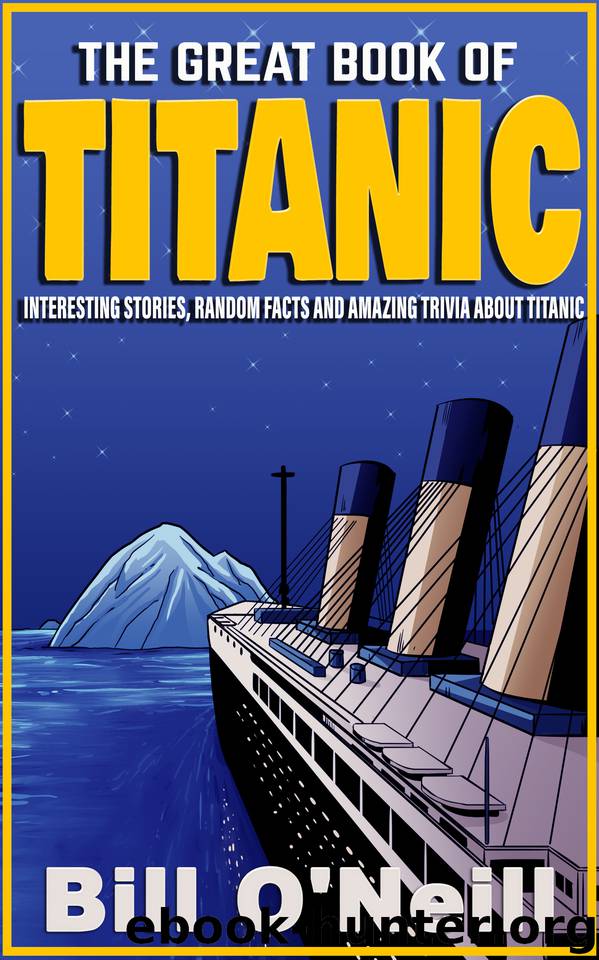The Great Book of Titanic: Interesting Stories, Random Facts and Amazing Trivia About Titanic by O'Neill Bill

Author:O'Neill, Bill [O'Neill, Bill]
Language: eng
Format: epub
Published: 2019-09-10T16:00:00+00:00
Iceberg Alley
The Atlantic Marine Ecozone, better known colloquially as “Iceberg Alley,” is an area of the North Atlantic Ocean known for its deep stretches of water and hundreds to thousands of icebergs of varying sizes floating around at any given time. The area stretches from the Davis Strait, which is between Greenland the Canadian territory of Nanavut, down to the Grand Banks off the coasts of the Canadian provinces of Newfoundland and Nova Scotia.
Along with the hazards of icebergs, mariners traversing Iceberg Alley have also had to historically deal with heavy fog caused by the cold waters.
Because of all these factors, only sailors with sharp reflexes usually make the voyage and even they usually do so in a very conservative manner—it doesn’t pay to try to rush through Iceberg Alley.
Iceberg Alley was no place for a sixty-one-year-old captain with recent history of accidents.
An Ancient Iceberg
Of all the characters in the Titanic saga, perhaps the most overlooked and underappreciated is the iceberg that the ship hit. We’ll call said iceberg—the Iceberg. I mean, come on, doesn’t it deserve some respect? It sort of did have a personality and it certainly had a backstory worth exploring.
So let’s take a look at the “Iceberg.”
The Iceberg, like 90% of the other icebergs in iceberg alley, came from the glaciers of Greenland. The water/ice of the Iceberg was therefore entirely fresh water, but scattered within the ice were numerous rocks and grit, some quite large.
Scientists now believe that Iceberg was first formed in Greenland thousands of years prior before hitting the Titanic, maybe as far back as 100,000 years. Yes, 100,000 years ago, when humans were still living in caves and none had even contemplated traversing the Atlantic Ocean. This is not to say that the Iceberg was floating around the Atlantic Ocean for thousands of years, but only that its snow and ice was that old. Once it broke off from the glacier of Greenland and began head south, it did so at a rate of between a half mile per hour and three miles per hour. So it may have been in the water for a few years before it met the Titanic.
And this was no tiny iceberg.
It is believed that the Iceberg was about 400 feet long and weighed around one and half metric tons. When you consider that 90% of icebergs are actually underwater, the Iceberg was truly a massive edifice.
And this was a tough iceberg.
In addition to the rocks and grit that partially comprised the Iceberg, North Atlantic iceberg ice tends to be very hard and strong. Although only about 10% as hard as concrete, iceberg ice is still much harder than an average ice cube and when combined with the rocks and grit they are capable of generating hundreds of tons of force if smashed against a ship’s hull.
And size does matter when it comes to the destructive force of icebergs.
Ignored Warnings
For historians, one of the most unfortunate results of the Titanic tragedy was that most of the crew and captain went down with the ship.
Download
This site does not store any files on its server. We only index and link to content provided by other sites. Please contact the content providers to delete copyright contents if any and email us, we'll remove relevant links or contents immediately.
The Infinite Retina by Robert Scoble Irena Cronin(6161)
Harry Potter and the Cursed Child: The Journey by Harry Potter Theatrical Productions(4440)
The Sports Rules Book by Human Kinetics(4290)
Molly's Game: From Hollywood's Elite to Wall Street's Billionaire Boys Club, My High-Stakes Adventure in the World of Underground Poker by Molly Bloom(3485)
A Knight of the Seven Kingdoms by George R R Martin(3191)
Quidditch Through the Ages by J.K. Rowling(3062)
How To by Randall Munroe(3032)
Flowers For Algernon by Daniel Keyes(3021)
Quidditch Through the Ages by J K Rowling & Kennilworthy Whisp(2929)
Quidditch Through the Ages by Kennilworthy Whisp by J.K. Rowling(2812)
Stacked Decks by The Rotenberg Collection(2811)
Quidditch through the Ages by J. K. Rowling(2768)
Quidditch Through The Ages by J. K. Rowling(2730)
776 Stupidest Things Ever Said by Ross Petras(2694)
Ready Player One: A Novel by Ernest Cline(2649)
What If?: Serious Scientific Answers to Absurd Hypothetical Questions by Randall Munroe(2637)
Beautiful Oblivion by Jamie McGuire(2569)
The Book of Questions: Revised and Updated by Gregory Stock Ph.d(2517)
Champions of Illusion by Susana Martinez-Conde & Stephen Macknik(2414)
